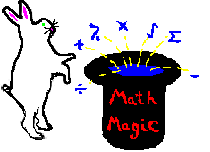

A. A derivative is calculated the exact opposite to that of an integral.
B. A function's derivative is basically the equation for the slope of the original function. Derivatives are usually expressed by: f '(x) or y' or dy/dx. f '(x) or y' is the first derivative. f ''(x) or y'' is the second derivative and so on.
C. Below are the basic rules for computing derivatives.
1. The derivative of a constant is 0.
Ex [1] dy/dx 5 = 0.
2. The derivative of xn is n*xn-1.
Ex [2] dy/dx 3x2 = 6x.
3. The
derivative of f(x) ![]() g(x) = f '(x)
g(x) = f '(x)
![]() g'(x)
g'(x)
Ex [3] dy/dx 6x3 + 4x2 + 8x - 4 = _________
a. This rule means you can take each term separately.
b. So this becomes dy/dx 6x3 + dy/dx 4x2 + dy/dx 8x - dy/dx 4 = 18x2 + 8x + 8 - 0.
c. The answer is 18x2 + 8x + 8.
4. The derivative of [f(x)]n is f '(x)*[f(x)]n-1.
Ex [4] dy/dx (3x2+5x+2)3 = ________
a. You always want to work from the inside out.
b. The first step is to take the derivative of the inside first. So dy/dx 3x2 + 5x + 2 = 6x + 5. This represents f '(x).
c. Now, we need the derivative of the outside which is 3(3x2+5x+2)2.
d. Now, multiplying these two values together gives:
(6x+5)*3*(3x2+5x+2)2 or (18x+15)(3x2+5x+2)2.
5. The derivative of f(x)*g(x) = f '(x)g(x)+f(x)g'(x).
a. This type of problem will probably not be found on a number sense test.
Ex [5] dy/dx (3x-4)(x2-3) = _________
a. First, multiply the derivative of the first times the second. So we get: dy/dx 3x - 4 = 3. So 3(x2-3) is the first term.
b. Next, multiply the first term times the derivative of the second. So we get: dy/dx x2 - 3 = 2x. So we get 2x(3x-4) for the second term.
c. The answer is 3(x2-3)+2x(3x-4).
D. Common Derivatives:
1. The derivative of sin(f(x)) = f '(x)*cos(f(x)).
2. The derivative of cos(f(x)) = -f '(x)*sin(f(x)).
3. The derivative of tan(f(x)) = f '(x)*sec2(f(x)).
4. The derivative of ef(x) = f '(x)*ef(x).
5. The derivative of ln (f(x)) = f '(x)*1/f(x).
E. Examples
Ex [1] If
f(x) = sin 4x, then f '(![]() ) =
_______
) =
_______
a. First, take the derivative of 4x which is 4.
b. The derivative of sin x is cos x, so the derivative of sin 4x = 4 cos 4x.
c. Plugging
in x = ![]() , we get 4 cos
, we get 4 cos ![]() =
4(-1) = -4.
=
4(-1) = -4.
d. The answer is -4.
Ex [2] Find the slope of the tangent line of y = (x-2)3 at the point x = 4.
a. Since a derivative is the slope of the tangent line, we need to find y' and use the value x = 4 to find the slope.
b. y' = 3(x-2)2, so plugging in x=4 we get 3(22) = 12.
c. The answer is 12.
Ex [3] If f(x) = 4x3 - 12x2 + 4x - 3, then f ''(2) = ______
a. For this problem we are looking for the second derivative. So we need to find the derivative of the derivative, or just take the derivative twice.
b. f '(x) = 12x2 - 24x + 4
c. So f ''(x) = 24x - 24. f ''(2) = 24(2) - 24 = 24.
d. The answer is 24.